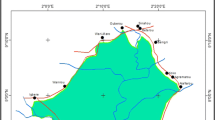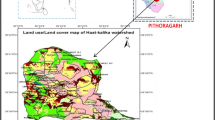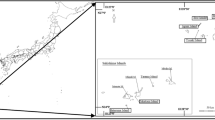Abstract
The purpose of this study was to analyze the utilization of tree species within and around the borders of the Maya Biosphere Reserve in Guatemala and to compare two sampling methodologies for the acquisition of such data. Residents in the communities of Caoba (border of reserve) and Uaxactún (within reserve) demonstrated significantly different utilization of tree species. Differences were due to the unique ecological and socio-economic conditions in each of the towns. Residents of both communities relied most heavily onSwietenia macrophylla, Manilkara achras. Cedrela odorata, Pouteria mammosa and Caesalpinia spp. Residents of Caoba considered 39% of all useful tree species to be marketable compared with only 18% in Uaxactún. Overall, more than 80 tree species were identified as useful in each of the communities. Changes in forest composition along with dynamic economic conditions were found to be altering the commercial utilization of tree species throughout the region. Some suggestions are offered for community development projects.
Similar content being viewed by others
Literature Cited
Aguilar-Cúmes, J. M. 1967. Untitled (tree identification guide). Guatemala, CA.
Alcorn, J. B. 1989. An economic analysis of Haustec Mayan forest management. Pages 182–208in J. Browder, ed., Fragile lands of Latin America: Strategies for sustainable development. Westview Press, Boulder, CO, USA.
Anonymous. 1979. Fomento y desarrollo economico de El Petén. Guatemala, CA.
Ascension, E. 1988. Seminario, los bosques del de-partamento de Petén. Santa Elena, Petén, Guatemala, CA.
Boom, B. M. 1989. Use of plant resources by the Chácobo. Pages 78–96in D. A. Posey and W. Bal-eá, eds., Resource management in Amazonia: Indigenous and folk strategies. Advances in Economic Botany, Vol 7. New York Botanical Garden, Bronx, NY, USA.
Browder, J. O. 1992. The limits of extractivism. BioScience 42:174–181.
Carneiro, R. L. 1978. The knowledge and use of rain forest trees by the Kuikuru Indians of central Brazil. Pages 201-216in R. I. Ford, ed., The nature and status of ethnobotany. University of Michigan, Ann Arbor, MI, USA.
Centro de Estudios Conservacionistas. 1991. Den-drologia tropical: Manual para guardarrecursos. Universidad de San Carlos de Guatemala, Guatemala, CA.
Chapin, M. 1992. Disappearing forests; disappearing peoples. Cultural Survival Quaterly Fall:63–68.
Davis, S. H. 1991. Sembrando las semillas de la vi-olencia. Pages 19–63in R. M. Carmack, ed. Guatemala: Cosecha de violencias. Guatemala, CA.
Estrada-Loera, E. 1991. Phytogeographic relationships of the Yucatan Peninsula. Journal of Bioge-ography 18:687–697.
Fomento y Desarrollo Economico de El Pe’en and Food and Agriculture Organization (FYDEP and FAO). 1970. Paralel 17: El Peten. Guatemala, CA.
Godoy, R, and R. Lubowski. 1991. Guidelines for the economic valuation of non-timber tropical forest products. Current Anthropology 33:423–31.
Gomez-Pompa, A., and A. Kaus. 1990. Traditional management of tropical forests in Mexico. Pages 43-60in A. B. Anderson, ed., Alternatives to deforestation: Steps toward sustainable use of the Amazon rain forest. Columbia University Press, New York, NY, USA.
Hartshorn, G. S. 1988. Tropical and subtropical vegetation of Meso-america. Pages 365-390in M. G. Barbour and W. D. Billings, eds., North American terrestrial vegetation. Cambridge University Press, New York, NY, USA.
Holdridge, L. R., W. C. Grenke, W. H. Hatheway, T. Liang, and J. A. Tosi, Jr. 1971. Forest environments in tropical life zones: A pilot study. Pergamon Press, Elmsford, New York, USA.
Langley, R. 1970. Practical statistics: Simply explained. Dover Publications, New York, NY, USA.
Leyden, B. W. 1984. Guatemalan forest synthesis after pleistocene aridity. Proceedings of the National Academy of Science 81:4856–4859.
Lundell, C. L.. 1937. Vegetation of Peten. Carnegie Institution, Washington, DC, USA.
Mutchnick, P. A. 1994. A vegetation study and eth-nobotanical analysis of tree species in the subtropical moist forest of Pet’en, Guatemala. Thesis. Ohio University, Athens, OH, USA.
Nations, J. D. 1988. Biodiversity in Guatemala: Biological diversity and tropical forests assessment. Center for International Development and Environment, World Resources Institute, Washington, DC, USA.
—. 1992. Xateros, Chicleros, and Pimenteros: Harvesting renewable tropical forest resources in the Guatemalan, Peten. Pages 208–219in K. H. Redford and C. Padoch, eds. Conservation of neotropical forests. Columbia University Press, New York, NY, USA.
Ozaeta, A. 1992. Diagnostico general de Uaxactoen. Guatemala, Central America.
Peters, C. M., A. H. Gentry, and R. O. Mendelsohn. 1989. Valuation of an Amazonian rainforest. Nature 339:655–656.
Phillips, O. and A. H. Gentry. 1993. The useful plants of Tambota, Peru: II: Additional hypothesis testing in quantitative ethnobotany. Economic Botany 47:33–43.
Plotkin, M. and L. Famolare. 1992. Sustainable harvest and marketing of rainforest products. Island Press, Washington, DC, USA.
Prance, G. T. 1987. Biogeography of neotropical plants. Pages 46–65in T. C. Whitmore and G. T. Prance, eds., Biogeography and quaternary history in tropical America. Oxford University Press, New York, NY, USA.
—. 1989. Introduction.In D. A. Posey and W. Baleé, eds., Resource management in Amazonia: Indigenous and folk strategies. Advances in Economic Botany, Vol 7., New York Botanical Garden, Bronx, NY, USA.
—,W. Balee, and R. L. Carneiro. 1987. Quantitative ethnobotany and the case for conservation in Amazonia. Conservation Biology 1:296–301.
Puleston, D. E. 1973. Ancient Maya settlement pat- terns and environment at Tikal, Guatemala: Impli- cations for subsistence models. Dissertation. University of Pennsylvania, Philadelphia, PA, USA.
Rees, W. E. 1990. The ecology of sustainable development. The Ecologist 20:93–111.
Reining, C., R. Heinzman, M. Cabrera, M. S. Lopez, and A. Solorzano. 1992. Non timber prod- ucts of the Maya Biospere Reserve, Peten, Guatemala. Conservation International Foundation, Washington, DC, USA.
Rico-Gray, V., A. Chemas, and S. Mandujano. 1991. Uses of tropical deciduous forest species by the Yucatecan Maya. Agroforestry Systems 14: 149–161.
Standley, P. C. and S. J. Record. 1936. The forests and flora of British Honduras. Field Museum of Natural History, Chicago, IL, USA.
—and J. A. Steyermark. 1958. Flora of Gua- temala. Fieldiana: Botany 24, Part 1. Natural History Museum, Chicago, IL, USA.
Schwartz, N. 1990. Forest society: A social history of the Peten, Guatemala. University of Pennsylvania Press, Philadelphia, PA, USA.
Toledo, V. M., A. L Batis, R. Becerra, E. Martinez, and C. H. Ramos. 1992. Products from the tropical rain forests of Mexico: An ethnoecological approach. Pages 89–109in M. Plotkin and L. Famolare, eds., Sustainable harvest and marketing of rainforest products. Island Press, Washington, DC, USA.
Turner, B. L. II and C. H. Miksicek. 1984. Economic plant species associated with prehistoric agriculture in the Maya lowlands. Economic Botany 38:179–193.
United States Agency for International Development/Government of Guatemala. 1991. Plan de accion forestal para Guatemala. Republica de Guatemala, CA.
United States International Development Cooperation Agency. 1990. Guatemala project paper: Maya biosphere project. Project #520-0395. Washington, DC, USA.
Vasquez-Pinedo, M., D. Zarin, P. Jipp, and J. Chota-Inuma. 1990. Use-values of tree species in a communal forest reserve in northeast Peru. Conservation Biology 4:405–413.
Walter, H. 1984. Vegetation of the earth and ecological systems of the geo-biosphere, third edition. Springer-Verlag, Stuttgart, Germany.
World Resources Institute. 1992. The 1992 Information please environmental almanac. Houghton Mifflin Co, Boston, MA, USA.
West, R. C. 1964. Surface configuration and associated geology of Middle America. Pages 33-83in R. C. West, ed., Handbook of Middle American Indians: Natural environment and early cultures. University of Texas Press, Austin, TX, USA.
Author information
Authors and Affiliations
Rights and permissions
About this article
Cite this article
Mutchnick, P.A., Mccarthy, B.C. An Ethnobotanical analysis of the tree species common to the subtropical moist forests of the petén, Guatemala. Econ Bot 51, 158–183 (1997). https://doi.org/10.1007/BF02893110
Received:
Accepted:
Issue Date:
DOI: https://doi.org/10.1007/BF02893110




